
Darwinia vestita, commonly known as pom-pom darwinia, is a species of flowering plant in the family Myrtaceae and is endemic to the southwest of Western Australia. It is an erect, bushy shrub with crowded egg-shaped, oblong, or linear leaves and more or less spherical heads of white to reddish-pink flowers.

Leucopogon plumuliflorus is a species of flowering plant in the heath family Ericaceae and is endemic to the south-west of Western Australia. It is a weakly erect shrub with egg-shaped leaves and spikes of white or pinkish-white, tube-shaped flowers.

Styphelia pendula is a species of flowering plant in the heath family Ericaceae and is endemic to the south-west of Western Australia. It is an erect, straggling shrub with oblong leaves and white, tube-shaped flowers that are bearded inside.

Leucopogon oldfieldii is a species of flowering plant in the heath family Ericaceae and is endemic to the south-west of Western Australia. It is an erect or spreading shrub with lance-shaped leaves and dense spikes of white or pink, tube-shaped flowers.

Conostephium minus, common name pink-tipped pearl flower, is a species of flowering plant in the family Ericaceae and is endemic to the southwest of Western Australia. It is an erect shrub with linear leaves and white and purplish-pink flowers.

Brachyloma preissii is a species of flowering plant in the heath family, Ericaceae, and is endemic to Western Australia. It is an erect, dense shrub with linear to oblong leaves and red, or pinkish-red, tube-shaped flowers.
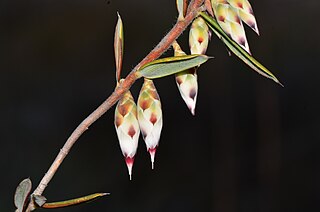
Conostephium hortiorum is a species of flowering plant in the family Ericaceae and is endemic to the south-west of Western Australia. It is a spreading shrub with linear, narrowly elliptic or narrowly triangular sharply-pointed leaves and pendulous, spindle-shaped, straw-coloured and dark purple flowers.

Styphelia brevicuspis is a species of flowering plant in the heath family Ericaceae and is endemic to the south-west of Western Australia. It is an erect, bushy shrub with oblong leaves with a small point on the tip, mostly about 1 mm (0.039 in) long. The flowers are arranged in groups of two or three in leaf axils with small bracts and bracteoles about half as long as the sepals. The sepals are about 4.2 mm (0.17 in) long and softly-hairy, the petal tube about the same length as the sepals but the petal lobes shorter than the petal tube.

Styphelia breviflora is a species of flowering plant in the heath family Ericaceae and is endemic to the south-west of Western Australia. It is an erect, spindly, glabrous shrub that typically grows to a height of up to about 1.5 m. It has oblong to lance-shaped or linear leaves 4–9 mm (0.16–0.35 in) long on a short petiole and with a small, rigid point on the tip. The flowers are borne singly or in pairs in leaf axils on a short peduncle with small bracts and bracteoles about half as long as the sepals. The sepals are about 2 mm (0.079 in) long and the petals white and about 4 mm (0.16 in) long, the petal lobes longer than the petal tube.

Styphelia insularis is a species of flowering plant in the heath family Ericaceae and is endemic to the south-west of Western Australia. It is a rigid, scrubby shrub with many branches, linear or oblong leaves and tube-shaped, white flowers.

Leucopogon lasiostachyus is a species of flowering plant in the heath family Ericaceae and is endemic to the south-west of Western Australia. It is an erect shrub with egg-shaped to lance-shaped leaves and dense, cylindrical spikes of tube-shaped white flowers on the ends of branches and in leaf axils.

Styphelia leptantha is a species of flowering plant in the heath family Ericaceae and is endemic to the south-west of Western Australia. It is an erect, bushy shrub that typically grows to a height of about 30 cm (12 in). Its leaves are erect, oblong or egg-shaped and 4–6 mm (0.16–0.24 in) long with a small, hard point on the tip. The flowers are arranged singly or in pairs in leaf axils with small bracts and bracteoles less than half as long as the sepals. The sepals are about 1.6 mm (0.063 in) long, the petals joined at the base to form a tube about 4 mm (0.16 in) long with lobes about 2 mm (0.079 in) long.

Conostephium preissii is a species of flowering plant in the family Ericaceae and is endemic to the southwest of Western Australia. It is an erect shrub with many stems, egg-shaped to oblong leaves and white and purplish to reddish-pink flowers.
Conostephium prolatum is a species of flowering plant in the family Ericaceae and is endemic to the south of Western Australia. It is an erect shrub usually with narrowly egg-shaped or narrowly triangular leaves with the narrower end toward the base, and more or less pendulous, spindle-shaped, cream to straw-coloured and dark purple flowers.
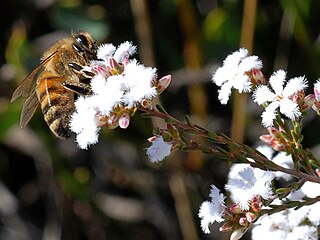
Leucopogon obtusatus is a species of flowering plant in the heath family Ericaceae and is endemic to the south-west of Western Australia. It is an erect shrub that typically grows to a height of 0.25–1 m. Its leaves are sessile, egg-shaped to oblong, overlap each other and are about 2 mm (0.079 in) long. The flowers are arranged in short, dense spikes on the ends of branches or in upper leaf axils with leaf-like bracts and broad bracteoles less than half as long as the sepals. The sepals are about 2 mm (0.079 in) long, the petals about 4 mm (0.16 in) long and joined at the base, the lobes shorter than the petal tube.
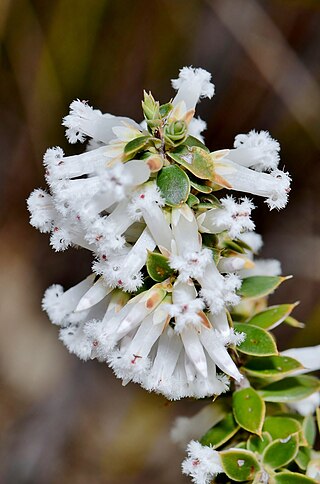
Styphelia erubescens is a species of flowering plant in the heath family Ericaceae and is endemic to the south-west of Western Australia. It is an erect shrub with variably-shaped leaves with a small, sharp point on the tip, and white, pink or red, tube-shaped flowers.
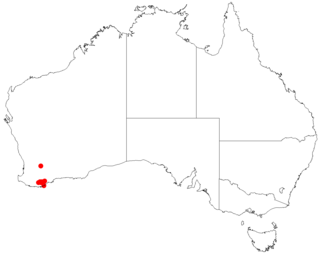
Styphelia pogonocalyx is a species of flowering plant in the heath family Ericaceae and is endemic to a restricted part of the south-west of Western Australia. It is an erect shrub with wand-like branches. Its leaves are erect, egg-shaped, 4–6 mm (0.16–0.24 in) long with a rigid, sharply-pointed tip on the end. The flowers are borne in leaf axils in pairs or threes with bracts and broad bracteoles about one-third as long as the sepals. The sepals are about 2 mm (0.079 in) long with bearded edges, and the petals are about 4 mm (0.16 in) long, the petal lobes as long as the petal tube and densely bearded.
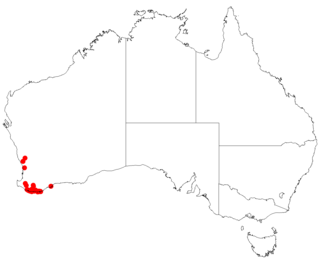
Leucopogon polystachyus is a species of flowering plant in the heath family Ericaceae and is endemic to the south-west of Western Australia. It is a slender, erect, usually glabrous shrub that typically grows to a height of 0.4–2 m. Its leaves are linear to lance-shaped, 8.5–17 mm (0.33–0.67 in) long with a rigid, sharply-pointed tip on the end. The flowers are borne on the ends of branches or in leaf axils in short, dense spikes with small, egg-shaped bracts and bracteoles about half as long as the sepals. The sepals are about 3.2 mm (0.13 in) long and often pale pink, and the petals are white, about 4 mm (0.16 in) long and joined at the base, forming a tube, the petal lobes longer than the petal tube.

Leucopogon strictus is a species of flowering plant in the heath family Ericaceae and is endemic to the southwest of Western Australia. It is an erect, rigid, more or less glabrous shrub with oblong to lance-shaped leaves and white, tube-shaped flower arranged singly or in pairs in leaf axils.
Acrotriche dura is a species of flowering plant in the family Ericaceae and is endemic to southern Western Australia. It is a slender, erect, glabrous shrub, with oblong to linear leaves, and spikes of tube-shaped white flowers, and flattened spherical drupes.

















